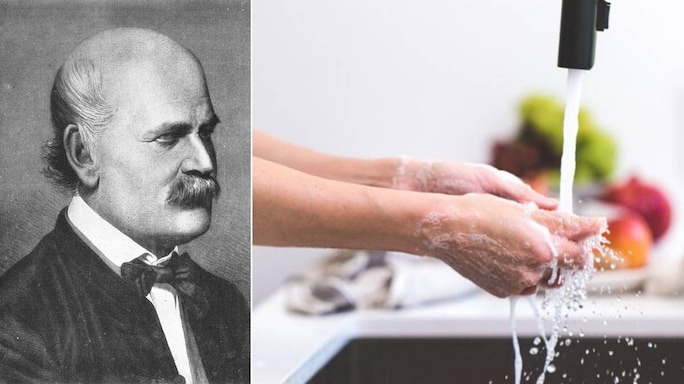- HOME
- /
- Features
- /
- Personalities
- /
The Man Who Discovered The Importance Of Washing Hands
Dr Ignaz Semmelweis had to face bitter opposition from the medical fraternity for his discovery and died a broken man
 Dr Ignaz Semmelweis' discovery of the importance of handwashing remained completely ignored during his lifetime. (Images: Wikimedia Commons, Pexels)
Dr Ignaz Semmelweis' discovery of the importance of handwashing remained completely ignored during his lifetime. (Images: Wikimedia Commons, Pexels)
Believe it or not, the concept of handwashing was largely ignored even in the mid-1800s across the world.
One of the key reasons behind doctors turning a blind eye to this practice during those days was their antiquated understanding of what caused diseases. Before the singular, revolutionary discoveries of Louis Pasteur and Robert Koch, the medical community (in Europe particularly) believed that diseases were caused due to miasma (poisonous air). Thus, be it cholera or plague, whenever an epidemic broke out, the general response of ordinary people would be to fasten the doors and shutters of their houses in an effort to prevent the ‘bad air’ from seeping into their homes.
These misguided notions and flawed understanding on the matter stood contrary to the facts. The story of Ignaz Semmelweis, now popularly believed to be the father of handwashing, bears testament to this. In 1848, Dr Semmelweis, a Hungarian doctor working at the Vienna General Hospital, was puzzled by the fact that maternal deaths from the dreaded childbed fever (puerperal fever) in a doctor-led ward was much higher than in clinics run by midwives. On closer observation, he found that many of the doctors (mostly trainees) would help in deliveries right after cutting cadavers and corpses at the hospital morgue, without washing their hands.
Mistaken though he was about the real cause of the infection and how it spread (this was the 1840s, a few decades before the knowledge that germs caused diseases was established), Dr Semmelweis nevertheless, as an experiment, decided to have the hospital’s doctors wash their hands and instruments in a chlorine solution. This was to get rid of the ‘cadaverous particles and smells’, which he believed made their way from the physicians’ hands and instruments into the bodies of the mothers. Surprisingly, the mortality rate dropped from 18 per cent to about one per cent. Thus was made the successful discovery and scientific demonstration of handwashing as a life-saving practice.
Dr Semmelweis, however, did not live to see the fruits of his discovery. Instead, the medical community in Vienna didn’t take lightly to his suggestion. Many doctors found it hard to accept that diseases spread through them and they were highly offended.
Dr Semmelweis was admitted to a psychiatric institution and died a broken man in 1865. The world would have to wait another 50 years before Dr Semmelweis’ discovery was finally taken seriously. By that time, Pasteur’s and Koch’s discoveries had already shaken the foundations of pathology, which, in turn, led handwashing to become the household practice it is today.






